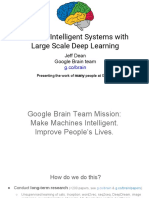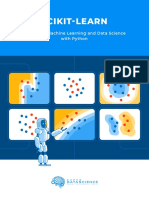Pytorch Cheatsheet EN
Uploaded by
Eirini EiriniPytorch Cheatsheet EN
Uploaded by
Eirini EiriniPyTorch CHEAT SHEET
1 Load data 2 Define model 3 Train model 4 Evaluate model
General Define model class Net(nn.Module):
def __init__():
Save/Load model
PyTorch is a open source machine learning framework. It uses torch.Tensor – multi-dimensional super(Net, self).__init__() model = torch.load('PATH') Load model
matrices – to process. A core feature of neural networks in PyTorch is the autograd package, There are several ways to
define a neural network in self.conv torch.save(model, 'PATH') Save model
which provides automatic derivative calculations for all operations on tensors. = nn.Conv2D( , , )
PyTorch, e.g. with
nn.Sequential (a), as a self.pool It is common practice to save only the model parameters, not the
import torch Root package torch.randn(*size) Create random tensor = nn.MaxPool2D( ) whole model using model.state_dict()
class (b) or using a
import torch.nn as nn Neural networks torch.Tensor(L) Create tensor from list combination of both. self.fc = nn.Linear( , )
from torchvision import Popular image datasets, tnsr.view(a,b, ...)Reshape tensor to
datasets, models, transforms architectures & transforms size (a, b, ...)
def forward(self, x):
import torch.nn.functional as F Collection of layers, requires_grad=True tracks computation history
activations & more for derivative calculations x = self.pool(
model = nn.Sequential( F.relu(self.conv(x))
nn.Conv2D( , , ) )
Layers nn.ReLU() GPU Training
nn.Linear(m, n): Fully Connected nn.ConvXd(m, n, s): X-dimensional x = x.view(-1, )
nn.MaxPool2D( ) device = torch.device('cuda:0' if torch.cuda.is_available() else 'cpu')
layer (or dense layer) from convolutional layer from m to n channels x = self.fc(x)
m to n neurons nn.Flatten()
with kernel size s; X {1, 2, 3}
nn.Linear( , ) return x If a GPU with CUDA support is available, computations are sent to
the GPU with ID 0 using model.to(device) or
nn.Flatten(): Flattens a contiguous nn.MaxPoolXd(s): X-dimensional pooling ) a model = Net() b inputs, labels = data[0].to(device), data[1].to(device).
range of dimensions into a tensor layer with kernel size s; X {1, 2, 3}
nn.Dropout(p=0.5): Randomly
Train model
nn.BatchNormXd(n): Normalizes a X-dimensional
sets input elements to zero during input batch with n features; X {1, 2, 3} LOSS FUNCTIONS
training to prevent overfitting
PyTorch already offers a bunch of different
loss fuctions, e.g.:
nn.Embedding(m, n): Lookup table nn.RNN/LSTM/GRU: Recurrent networks nn.L1Loss Mean absolute error
to map dictionary of size m to connect neurons of one layer with neurons of the
embedding vector of size n same or a previous layer nn.MSELoss Mean squared error (L2Loss)
nn.CrossEntropyLoss Cross entropy, e.g. for single-label
torch.nn offers a bunch of other building blocks. classification or unbalanced training set
A list of state-of-the-art architectures can be found at https://paperswithcode.com/sota.
nn.BCELoss Binary cross entropy, e.g. for multi-label
classification or autoencoders
Load data Activation functions OPTIMIZATION (torch.optim)
A dataset is represented by a class that Common activation functions include ReLU,
inherits from Dataset (resembles a list Optimization algorithms are used to update
Sigmoid and Tanh, but there are other activation weights and dynamically adapt the learning
of tuples of the form (features, label)). functions as well. rate with gradient descent, e.g.:
DataLoader allows to load a dataset optim.SGD
nn.ReLU() creates a nn.Module for example to be used in Stochastic gradient descent
without caring about its structure.
Sequential models. F.relu() ist just a call of the ReLU function optim.Adam Adaptive moment estimation
Usually the dataset is split into training e.g. to be used in the forward method.
optim.Adagrad Adaptive gradient
(e.g. 80%) and test data (e.g. 20%).
optim.RMSProp Root mean square prop
nn.ReLU() or F.relu()
Output between 0 and ∞,
most frequently used activation function
Evaluate model
The evaluation examines whether the model provides
nn.Sigmoid() or F.sigmoid() satisfactory results on previously withheld data.
Output between 0 and 1, Depending on the objective, different metrics are used,
often used for predicting probabilities such as acurracy, precision, recall, F1, or BLEU.
model.eval() Activates evaluation mode, some layers
nn.Tanh() or F.tanh() behave differently
Output between -1 and 1, torch.no_grad() Prevents tracking history, reduces memory
often used for classification with two classes usage, speeds up calculations
Stefan Seegerer, hi@stefanseegerer.de Matthias Zürl, matthias.zuerl@fau.de CC-BY-SA Last updated: 10/2021
You might also like
- What Is A Support Vector Machine?: PrimerNo ratings yetWhat Is A Support Vector Machine?: Primer3 pages
- Pytorch Tutorial For Beginner: Department of Computer Science & Engineering University of WashingtonNo ratings yetPytorch Tutorial For Beginner: Department of Computer Science & Engineering University of Washington11 pages
- Instant Download Pandas Workout (MEAP V06) Reuven Lerner PDF All Chapters100% (2)Instant Download Pandas Workout (MEAP V06) Reuven Lerner PDF All Chapters37 pages
- Buy ebook (Ebook) Hands-on Scikit-Learn for machine learning applications: data science fundamentals with Python by David Paper ISBN 9780933333338, 9781484253724, 9781484253731, 9789109027774, 0933333331, 1484253728, 1484253736, 9109027777 cheap price100% (8)Buy ebook (Ebook) Hands-on Scikit-Learn for machine learning applications: data science fundamentals with Python by David Paper ISBN 9780933333338, 9781484253724, 9781484253731, 9789109027774, 0933333331, 1484253728, 1484253736, 9109027777 cheap price65 pages
- Intro To Machine Learning With TensorFlow Nanodegree Program SyllabusNo ratings yetIntro To Machine Learning With TensorFlow Nanodegree Program Syllabus15 pages
- Full download Neural Networks A Visual Introduction for Beginners Michael Taylor pdf docx100% (1)Full download Neural Networks A Visual Introduction for Beginners Michael Taylor pdf docx65 pages
- Mehryar Mohri - Foundations of Machine Learning - BookNo ratings yetMehryar Mohri - Foundations of Machine Learning - Book1 page
- Scikit-Learn: Library For Machine Learning and Data Science With PythonNo ratings yetScikit-Learn: Library For Machine Learning and Data Science With Python11 pages
- Computer Vision Pretrained Models: What Is Pre-Trained Model?No ratings yetComputer Vision Pretrained Models: What Is Pre-Trained Model?10 pages
- Download Complete Math and Architectures of Deep Learning Final Release 1st Edition Krishnendu Chaudhury PDF for All Chapters100% (1)Download Complete Math and Architectures of Deep Learning Final Release 1st Edition Krishnendu Chaudhury PDF for All Chapters41 pages
- Figure Style and Scale: Darkgrid Whitegrid Dark White Ticks DarkgridNo ratings yetFigure Style and Scale: Darkgrid Whitegrid Dark White Ticks Darkgrid15 pages
- Machine Learning: Andrew NG's Course From Coursera: Presentation100% (1)Machine Learning: Andrew NG's Course From Coursera: Presentation4 pages
- Stock Price Prediction Using Machine Learning With PythonNo ratings yetStock Price Prediction Using Machine Learning With Python10 pages
- Machine Learning - Stanford University - CourseraNo ratings yetMachine Learning - Stanford University - Coursera16 pages
- G5Aiai Introduction To AI: Graham KendallNo ratings yetG5Aiai Introduction To AI: Graham Kendall48 pages
- A Gentle Introduction To Neural Networks With PythonNo ratings yetA Gentle Introduction To Neural Networks With Python85 pages
- NLTK: The Natural Language Toolkit: Steven Bird Edward LoperNo ratings yetNLTK: The Natural Language Toolkit: Steven Bird Edward Loper4 pages
- Full Deep Learning With Python Develop Deep Learning Models On Theano and TensorFLow Using Keras Jason Brownlee Ebook All Chapters100% (3)Full Deep Learning With Python Develop Deep Learning Models On Theano and TensorFLow Using Keras Jason Brownlee Ebook All Chapters62 pages
- Lecture 01 (Introduction To Pattern Recognition)No ratings yetLecture 01 (Introduction To Pattern Recognition)26 pages
- Feature Selection Techniques in Machine Learning - JavatpointNo ratings yetFeature Selection Techniques in Machine Learning - Javatpoint9 pages
- Download ebooks file Machine Learning with Neural Networks: An Introduction for Scientists and Engineers Bernhard Mehlig all chaptersNo ratings yetDownload ebooks file Machine Learning with Neural Networks: An Introduction for Scientists and Engineers Bernhard Mehlig all chapters50 pages
- 02TSRevised Reinforcement Learning Ebook All Chapters PDFNo ratings yet02TSRevised Reinforcement Learning Ebook All Chapters PDF87 pages
- Online Machine Learning Algorithms For Currency Exchange PredictionNo ratings yetOnline Machine Learning Algorithms For Currency Exchange Prediction84 pages
- Pytorch Tutorial: - Ntu Machine Learning CourseNo ratings yetPytorch Tutorial: - Ntu Machine Learning Course64 pages
- The Fermentation Process of Beer in AfricaNo ratings yetThe Fermentation Process of Beer in Africa3 pages
- Preparation of Soymilk Using Different Methods: Food and Nutrition Sciences January 2016No ratings yetPreparation of Soymilk Using Different Methods: Food and Nutrition Sciences January 20168 pages
- NV Strip Type Fuse-Switch-Disconnector Sizes 00, 1, 2, 3No ratings yetNV Strip Type Fuse-Switch-Disconnector Sizes 00, 1, 2, 33 pages
- Full Download Serious Cycling 2nd Edition Edmund R. Burke PDF DOCX100% (15)Full Download Serious Cycling 2nd Edition Edmund R. Burke PDF DOCX60 pages
- BOMBAY SCOTTISH prelim paper with Answer keyNo ratings yetBOMBAY SCOTTISH prelim paper with Answer key9 pages
- Quantum Information Processing in Ion Traps II: Part I, Rainer BlattNo ratings yetQuantum Information Processing in Ion Traps II: Part I, Rainer Blatt27 pages

























































































